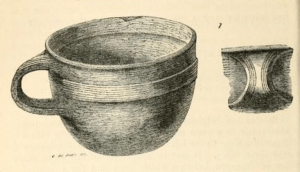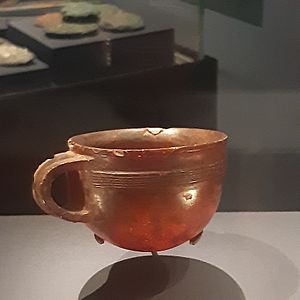Hove amber cup facts for kids
The Hove amber cup is a special cup from the Bronze Age. It was found in 1856 inside a large burial mound, called a round barrow, in Hove, East Sussex, England. Today, you can see this amazing cup at the Hove Museum and Art Gallery.
This cup was discovered when people were building Palmeira Square. The burial mound was very big and well-made, which tells us it was built around the middle of the Bronze Age. The Hove amber cup is one of only two amber cups ever found in Britain! The other one was found in Dorset, but it looks different.
What is the Hove Amber Cup?
This ancient cup is about 3,700 years old, dating back to around 1750 to 1550 BCE. It was found in a grave belonging to the Wessex culture, which was a group of people living in southern Britain during the Bronze Age. The cup was placed inside a coffin made from a hollowed-out tree trunk.
Inside the coffin, alongside the cup, archaeologists found a skeleton. They also found a dagger, a whetstone (a stone for sharpening tools), and a small axe. These items were likely buried with an important person.
How the Cup Was Made
The Hove amber cup is carved from a single piece of amber. Amber is fossilized tree resin, often found near the Baltic region in northern Europe. Finding an amber cup in Britain suggests that people living here long ago traded with people from far-off lands. This shows there were early trade routes connecting Britain with other parts of Europe.
The Hove amber cup is part of a small group of unique cups found across north-western Europe. These cups often have round bottoms, making them a bit "unstable" when placed down. They were made from precious materials like gold, silver, amber, or shale. In Britain, two famous gold cups are the Ringlemere Cup and the Rillaton Cup.




